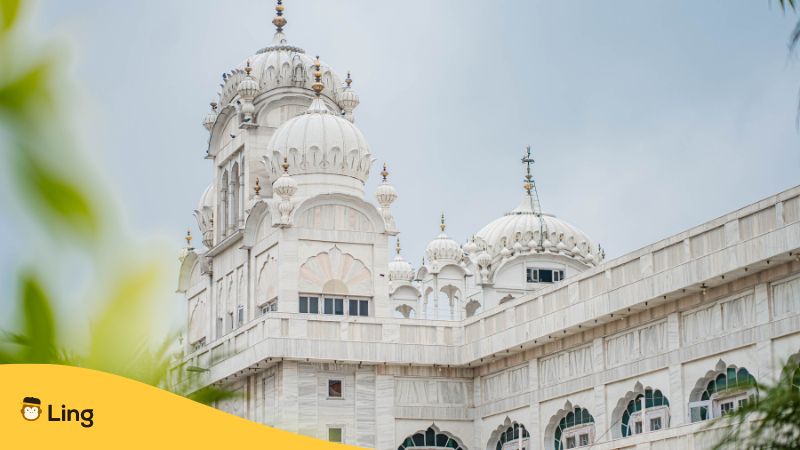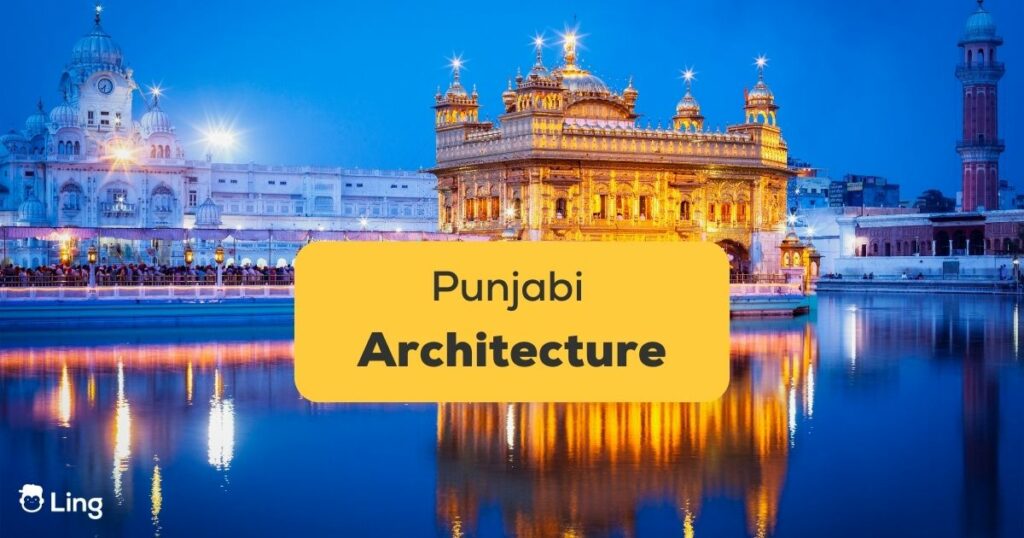Punjabi architecture is known for its intricate design, vibrant colors, and creative use of materials. This style of architecture has been popular in the region for centuries and has greatly influenced the culture and aesthetics of Punjab.
In this blog post, we’ll take a closer look at five unique features of Punjabi architecture as well as what the related terms are called in the Punjabi language. From the use of brickwork to incorporation of Sikh symbolism, these features make Punjabi architecture stand out from the rest. Read on to discover the secrets behind this fantastic style of architecture.
Terms Related To Punjabi Architecture
| English | Punjabi | Transcription |
|---|---|---|
| Building | ਇਮਾਰਤ | Imārata |
| Floor/ Storey | ਮਨਜ਼ਿਲ | Manazila |
| Corner | ਕੋਨਾ | Kōnā |
| Roof | ਛਤ | Chata |
| Door | ਦਰਵਾਜ਼ਾ | Daravāzā |
| Window | ਖਿੜਕੀ | Khiṛakī |
| Arch | ਸ਼ੈਲ | Śaila |
| Design | ਮੋਡਲ | Mōḍala |
| Dome | ਗੁੰਬਦ | Gubada |
History Of Punjabi Architecture
The architecture of Punjab has been influenced by centuries of human settlement and occupancy. Its style is an amalgamation of the various civilizations that have occupied the region, such as the Mughals, the Sikhs, and the British. Punjabi architecture is predominantly a mix of Hindu and Islamic styles, although it contains elements from other architectural traditions.
The oldest surviving examples of Punjabi architecture can be found in the ruins of ancient cities like Taxila and Harappa. These sites are characterized by their use of mud and stone, a construction still prevalent in modern-day Punjab. During the Mughal period (1526-1858), Punjab experienced a surge in architectural development. This included building forts and palaces, many of which were adorned with intricate carvings and decorated with beautiful tilework.
The architecture of Punjab also changed during the Sikh period (1799-1849). Sikh Gurudwaras, or temples, were built in large numbers throughout Punjab, and they often featured a distinct style of ornamentation that had become synonymous with the Sikh faith. During the British Raj (1858-1947), many colonial-style buildings were constructed in Punjab, such as Christian churches, government offices, and public schools.
Punjabi architecture is a distinctive style that has evolved over centuries, reflecting the influence of various civilizations occupying the region. It is characterized by a unique blend of Hindu and Islamic styles and includes buildings ranging from forts and palaces to religious temples and modern structures. Although it is no longer as prominent as it once was, it remains a fascinating part of Punjab’s cultural heritage.

The Havelis Of Punjab
The presence of many Havelis or traditional mansions marks the conventional architecture of Punjab. Intricate stone, wood carvings, arches, and vaulted ceilings characterize these structures. The Havelis were typically built by wealthy landowners and were used as family homes.
The Havelis were usually constructed out of mud and stone, with decorated exteriors and interiors. These beautiful structures often had large courtyards, gardens, and intricately carved balconies. In some cases, these Havelis featured multiple stories and elaborate murals and frescos.
The decoration of the Havelis was often quite elaborate, with decorative motifs such as flowers, animals, religious symbols, and geometric patterns used to create a unique aesthetic. The wooden beams that supported the roofs were also often elaborately carved to create a visually stunning effect.
The Havelis of Punjab reflect the region’s long history and cultural traditions. They remain a reminder of a time when Punjabi architecture was at its peak, and the area was home to some of the most ornate structures in India.
The Use Of Brick And Mortar
Brick and mortar have been famous in Punjabi architecture since ancient times. It is an affordable, easy-to-use, and durable material used to build structures of all sizes. From the foundations of buildings to the ornate outer walls, brick and mortar have been an integral part of Punjabi architecture for centuries.
The walls of Punjabi homes are made of brick and mortar, often constructed in a geometric pattern. This type of construction is believed to provide extra strength and stability to the structure, as well as help it withstand earthquakes. The use of brick and mortar is also aesthetically pleasing, with its simple yet elegant design.
In addition to being used in the walls, brick and mortar are also used for window frames, arches, and doorways. These architectural elements add character to the building and make it stand out from other structures. Furthermore, brick and mortar are often decorated with intricate designs such as floral motifs or geometric patterns, giving the building a unique look.
All in all, the use of brick and mortar has been a critical part of Punjabi architecture for centuries, and it continues to be an essential part of the region’s traditional buildings today.
The Jharokhas
The Jharokas, or “windows,” are a defining feature of Punjabi architecture. These ornamental windows are found on the upper level of the Havelis or grand mansions. These windows are designed with intricate carvings and are often painted bright colors.
The Jharokas were initially used to give women of the house a view of the streets below without being seen. The elaborate design and colors symbolize power and prosperity, signifying the owners’ wealth. Today, the jharokhas remain an important architectural feature, with many restored and maintained in their original condition.
It is believed that the Jharokas originated from Mughal influences. These windows can be found in many Havelis across Punjab and have become a symbol of Punjab’s rich cultural heritage. From small villages to large cities, these ornate windows glimpse Punjab’s past and remind it of its vibrant history.
Sikh Gurdwaras
Domes on Sikh gurdwaras/Sikh shrines are quite famous that sprout from a floral base and have immense historical significance. Each Sikh gurdwara shows Sikh architecture and is connected with ten gurus. The golden temple in Amritsar city and a Sikh gurdwara in Anandpur Sahib display the same design with a golden dome.
Wrapping Up
Now you know everything about Punjabi architecture. If you want to learn the Punjabi language, check out the Ling app, a language learning platform that can help you learn 60+ languages through its interactive and fun activities. You can also use its chatbot and quizzes to test your knowledge. So download the app from Google Playstore or App Store and start learning Punjabi!


































































